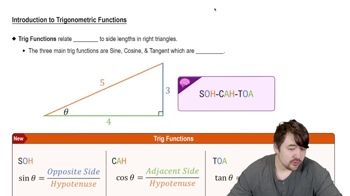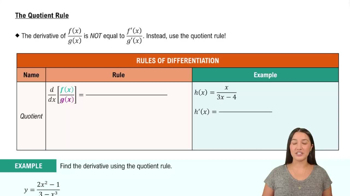Table of contents
- 0. Functions7h 52m
- Introduction to Functions16m
- Piecewise Functions10m
- Properties of Functions9m
- Common Functions1h 8m
- Transformations5m
- Combining Functions27m
- Exponent rules32m
- Exponential Functions28m
- Logarithmic Functions24m
- Properties of Logarithms34m
- Exponential & Logarithmic Equations35m
- Introduction to Trigonometric Functions38m
- Graphs of Trigonometric Functions44m
- Trigonometric Identities47m
- Inverse Trigonometric Functions48m
- 1. Limits and Continuity2h 2m
- 2. Intro to Derivatives1h 33m
- 3. Techniques of Differentiation3h 18m
- 4. Applications of Derivatives2h 38m
- 5. Graphical Applications of Derivatives6h 2m
- 6. Derivatives of Inverse, Exponential, & Logarithmic Functions2h 37m
- 7. Antiderivatives & Indefinite Integrals1h 26m
- 8. Definite Integrals4h 44m
- 9. Graphical Applications of Integrals2h 27m
- 10. Physics Applications of Integrals 3h 16m
- 11. Integrals of Inverse, Exponential, & Logarithmic Functions2h 34m
3. Techniques of Differentiation
Derivatives of Trig Functions
Problem 3.5.32
Textbook Question
23–51. Calculating derivatives Find the derivative of the following functions.
y = a sin x + b cos x/a sin x - b cos x; a and b are nonzero constants
 Verified step by step guidance
Verified step by step guidance1
Step 1: Identify the function for which you need to find the derivative. The function given is \( y = \frac{a \sin x + b \cos x}{a \sin x - b \cos x} \).
Step 2: Recognize that this is a quotient of two functions, so you will need to use the Quotient Rule for differentiation. The Quotient Rule states that if you have a function \( y = \frac{u(x)}{v(x)} \), then the derivative \( y' \) is given by \( y' = \frac{u'(x)v(x) - u(x)v'(x)}{(v(x))^2} \).
Step 3: Identify \( u(x) = a \sin x + b \cos x \) and \( v(x) = a \sin x - b \cos x \). Compute the derivatives \( u'(x) \) and \( v'(x) \). Use the derivatives of sine and cosine: \( \frac{d}{dx}(\sin x) = \cos x \) and \( \frac{d}{dx}(\cos x) = -\sin x \).
Step 4: Calculate \( u'(x) = a \cos x - b \sin x \) and \( v'(x) = a \cos x + b \sin x \).
Step 5: Substitute \( u(x) \), \( v(x) \), \( u'(x) \), and \( v'(x) \) into the Quotient Rule formula to find the derivative of \( y \). Simplify the expression if possible.
 Verified video answer for a similar problem:
Verified video answer for a similar problem:This video solution was recommended by our tutors as helpful for the problem above
Video duration:
7mPlay a video:
Was this helpful?
Key Concepts
Here are the essential concepts you must grasp in order to answer the question correctly.
Derivatives
A derivative represents the rate of change of a function with respect to its variable. It is a fundamental concept in calculus that allows us to determine how a function behaves at any given point. The derivative can be computed using various rules, such as the power rule, product rule, and quotient rule, depending on the form of the function.
Recommended video:

Derivatives
Trigonometric Functions
Trigonometric functions, such as sine and cosine, are periodic functions that relate angles to ratios of sides in right triangles. In calculus, these functions are essential for modeling oscillatory behavior and are frequently encountered in problems involving derivatives. Understanding their properties, such as their derivatives, is crucial for solving calculus problems involving these functions.
Recommended video:

Introduction to Trigonometric Functions
Quotient Rule
The quotient rule is a method for finding the derivative of a function that is the ratio of two other functions. It states that if you have a function y = u/v, where u and v are both differentiable functions, the derivative is given by (v * u' - u * v') / v^2. This rule is particularly useful when differentiating functions like the one in the question, where the function is expressed as a fraction.
Recommended video:

The Quotient Rule

 3:53m
3:53mWatch next
Master Derivatives of Sine & Cosine with a bite sized video explanation from Callie
Start learning




